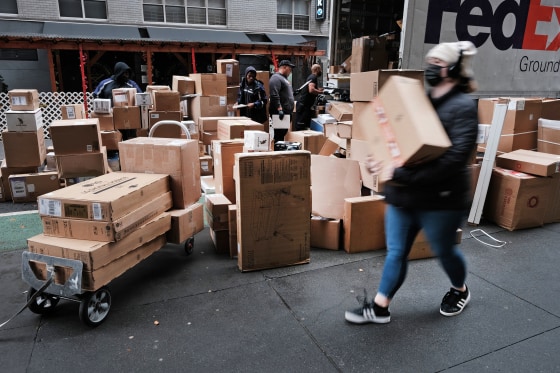The holiday season is still in full swing, but retailers are already preparing for an influx of returns at the end of the month — and it's expected to be bigger than years before.
Nearly two years into the coronavirus pandemic, in-store fitting rooms and makeup testers have become nearly obsolete, leaving shoppers to try on clothes and products at home with plans to return what they don’t want to keep. While that's convenient for shoppers, it poses a booming problem for retailers left to process — or discard — unwanted goods.
“Every year as e-commerce grew, [returns were] becoming a bigger problem,” said Praveen Adhi, the lead of retail operations for the Americas for the consulting firm McKinsey. “Then, in March 2020, there was a giant step change, and suddenly retailers had no choice because more people started shopping online and have remained shopping online. It became too much a part of the business to ignore.”
Online shopping sales are expected to reach $207 billion this year, a 10 percent increase from last year, according to the Adobe Digital Economy Index. But with out-of-stock issues and supply chain constraints, shoppers have been buying whatever they can get their hands on out of fear that their gifts won’t arrive in time for the holidays, Sender Shamiss, the CEO of the logistics company goTRG, said by email.
From Thanksgiving to the end of January, $120 billion of goods is expected to be returned, according to the reverse logistics technology company Optoro, up by about 4 percent from $115 billion last year.
This year, shoppers are expected to return 30 percent to 40 percent of online purchases.
“The focus on returns has definitely intensified,” said Bill Inzeo, a global retail technology strategist at the retail technology company Zebra Technologies. “Retailers are looking for ways to lead customers to solutions to help align how they’re thinking about returns.”
Sizing and virtual reality technology to reduce returns before shoppers make purchases are still nascent when it comes to online shopping. In March, Snap Inc. expanded its e-commerce business with the acquisition of Fit Analytics, a virtual reality company that helps shoppers choose the right sizes of clothing online. Walmart shut down its virtual reality e-commerce subsidiary last year after just two years. Gap Inc. acquired the fit technology company Drapr in August to tackle the problem of returns.
“When we look at our returns, the No. 1 reason why people return product is because it doesn’t fit,” Gap CFO Katrina O’Connell said in an earnings call in September. “So being able to leverage the technology that Drapr brings to be able to create a better fit experience, we think, will show up in our return rate.”
But as adoption of the technologies drags along, businesses are working on new ways to tackle "bracketing," in which shoppers buy a range of sizes or colors of a single product intending to return what they don’t want. It's a trend industry watchers say has grown as shoppers move online. About 72 percent of shoppers who bought multiple sizes and colors of one item last year plan to use the strategy more, according to a recent report from branded returns company Narvar. About one-third of shoppers told the company that they will buy more of the same items because they can’t try things on in stores.
One-third of surveyed shoppers plan to buy more of the same item because they can’t try things on in stores.
“The stickiness of trends are staying even after stores reopen because of variant concerns — people got used to the convenience of e-commerce,” said Anisa Kumar, Narvar's chief customer officer. “Shoppers aren’t staying and hanging out [at a store], and 60 percent are buying items and taking it home with intent to return.”
Saks Fifth Avenue, Sephora, Bed Bath & Beyond and Levi’s all use advanced technology to give shoppers more options to make returns through their own stores or partner stores that accept returns on their behalf. Some companies, including Cole Haan, are using boxless returns, in which shoppers can return items to UPS stores without boxes, bypassing the cumbersome process of finding or buying packaging for the unwanted items. About 10 percent of shoppers choose that option when they make returns, Narvar said.
Some retailers, such as H&M and DSW, are also offering tiered return policies for loyal members. H&M waives the $5.99 return shipping fee loyalty members. DSW loyalty members are able to make returns within a year of purchase.
"Return costs and shipping costs have gone up," Kumar said. "You can’t afford to have inventory that is not sellable and takes longer to send back and have to mark it down."
Shamiss said the problem of online returns has only become more pressing in the supply chain crisis that has thinned out retail shelves. Before supply chain backups, goTRG resold returns on secondary marketplaces, which could drive up the items' resale value. Now, however, it is refurbishing returned items to fold back into retailers' supply chains to backfill inventory and keep up with consumer demand, he said.
Kumar said, “You need to get those returns back into your inventory base as fast as possible.”
The window to return items has also become wider with the rise of e-commerce. Macy’s spokesperson Sheikina Liverpool said in an email that most items bought online or in stores as of Oct. 5 will be accepted for return until Jan. 31 to provide additional flexibility for customers shopping throughout the holiday season. Kohl’s holiday return policy lets shoppers return items within 180 days, except for electronics.
